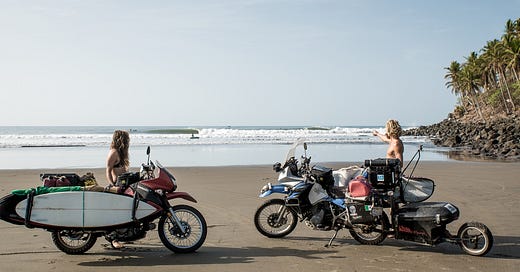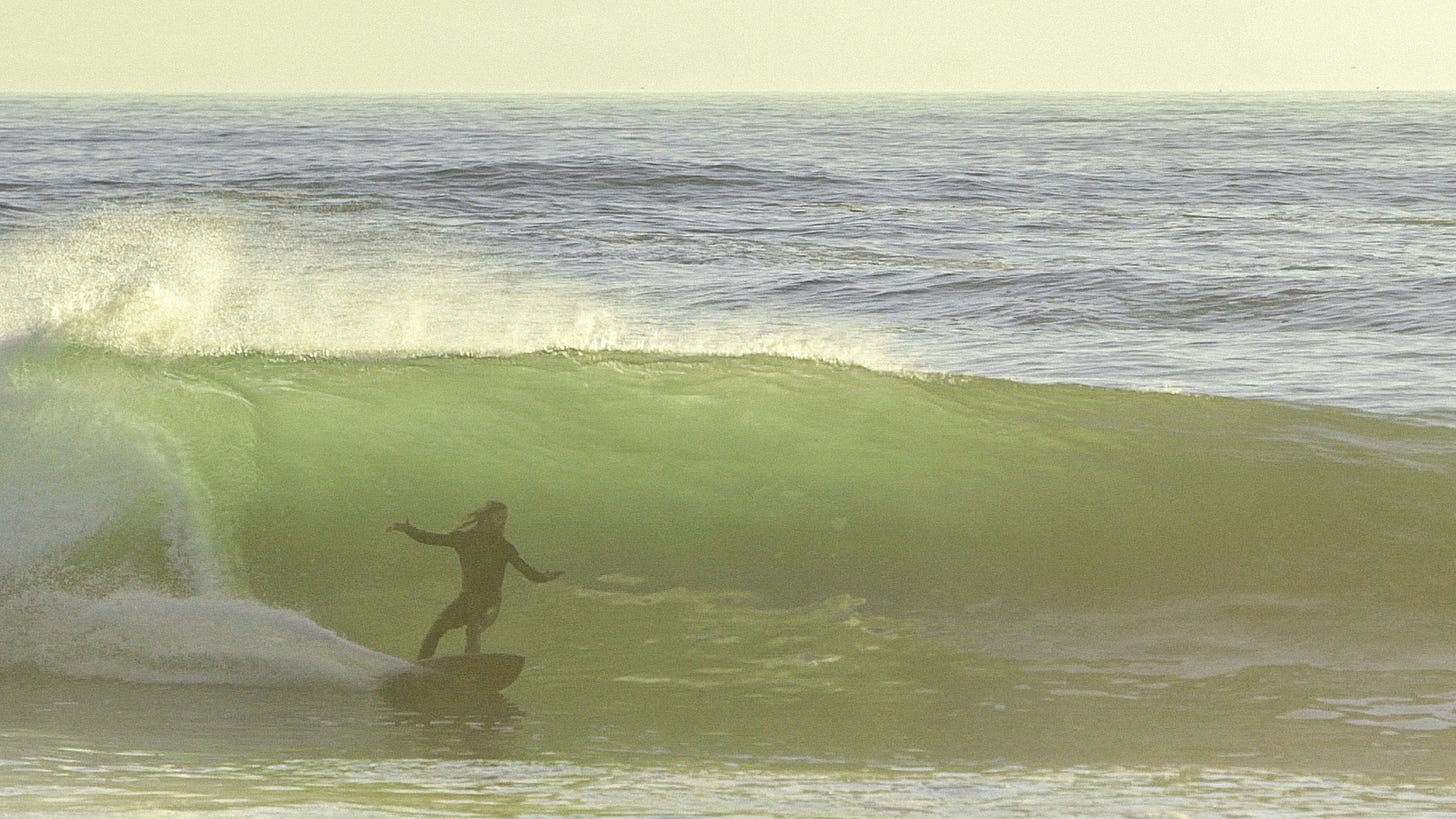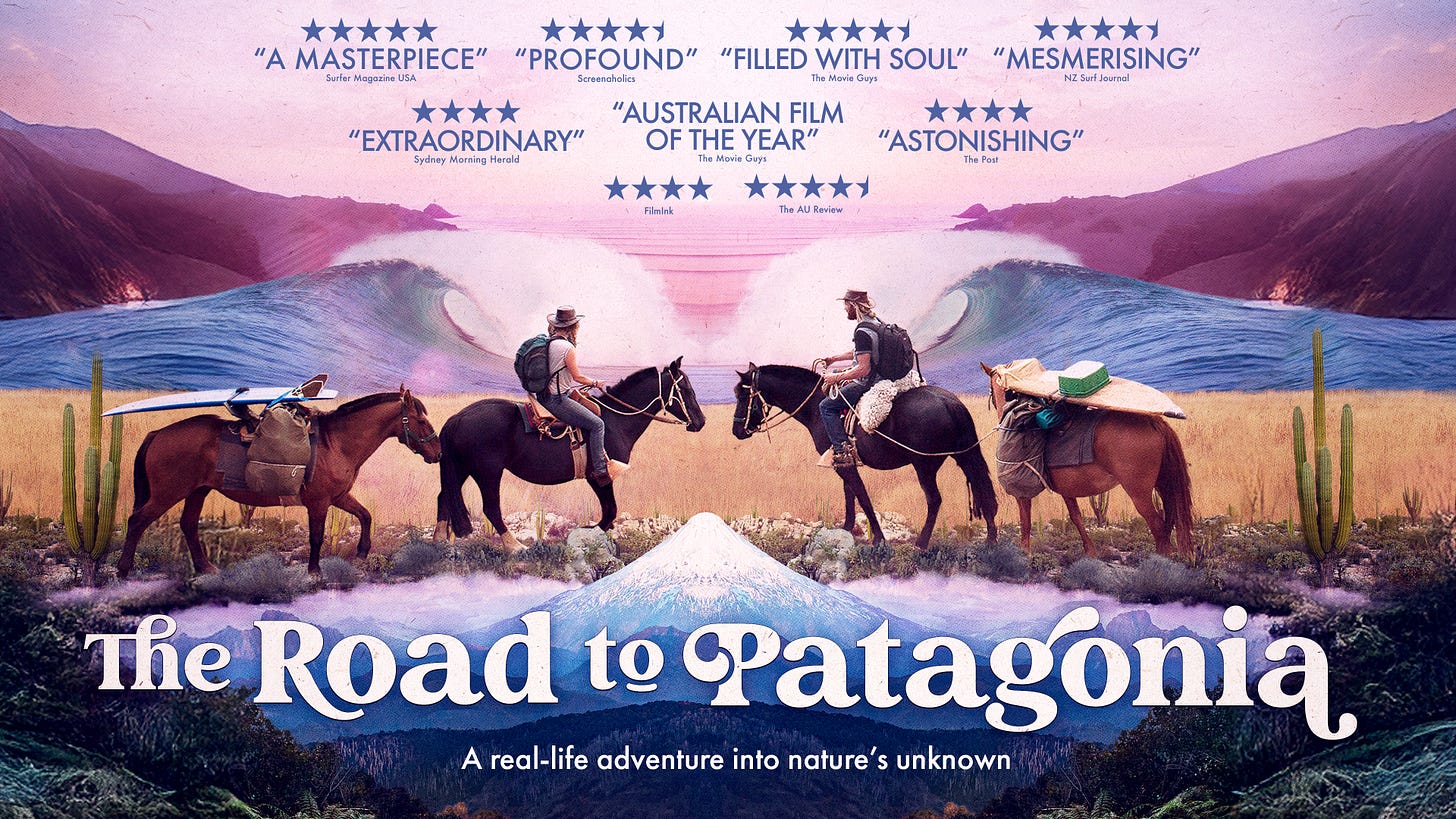“They laugh at us and our Western work ethic.”
An interview with surfer and filmmaker Matty Hannon, who lives on the east coast of Australia
“They laugh at us and our Western work ethic, always rushing around. Their favourite expression is: “Moile, moile,” which means: “Slowly, slowly.” For them, if you're rushing in the rainforest, very often you’ll stand on sharp things, or you might not see the deadly snake. You’ll also upset the spirits of the rainforest because you’re not paying attention and keeping your soul in a content and balanced state.”
When Matty Hannon was 31, he felt an existential ache that led him to ditch his job making commercials in Melbourne and embark on the ultimate surf road trip – a 50,000km odyssey from the Alaskan wilderness down to the tip of Tierra del Fuego.
The Road to Patagonia is a documentary chronicling that journey – which starts on a motorbike and ends by horseback – and indeed the very wisdom of the Anthropocene, with some incredible surf travel footage thrown in along the way.
When it was released in Australia and New Zealand in 2024, it struck such a chord with audiences that it became the highest grossing documentary of the year. I watched the film with my sons, who are 12 and 14, and we all loved it, so I was pretty excited to chat to Matty about what he learnt from the project, the highs and lows of life on the road and what he’s planning to work on next. Enjoy!
Where did the idea for The Road to Patagonia come from – did you originally set out to make a surf film?
No, I'm not a professional surfer or trying to pretend that anyone wants to look at my surfing for extended periods, haha.
Though you do surf the iconic big wave spot Mavericks in the film, don’t you? On a board borrowed from local legend Jeff Clark…
Well yes, but I did a masters in documentary making at university, and I’ve always been really interested in stories. I was more into trying to produce a documentary than a straight up surf film, but I had no idea what the framework would look like. I set off without a plan or really enough money to finish the movie, so it's amazing how it turned out.
How much footage did you record to make the film?
An outrageous amount. I filmed for about two and a half years, but I also had quite a lot of footage from when I was living in Indonesia in my early 20s. The edit took a really long time, and there were many points where I felt lost and wondered how I’d pull it altogether into something coherent.
This was my first feature film, and I had no idea if people were going to like it or not, so [with partner Heather who also stars in the film] we just decided to make the film we wanted to make. And if it bombed and never really got seen by anyone other than my mum and a few mates that would have been fine. It was a film that felt truthful to us – that was our needle on it.
Why do you think it has resonated with so many people?
There are probably a few strands that people identify with. There’s obviously the love story, which is a good hook – we're all human – and most of us like a happy ending.
Then there’s the adventure and surfing stuff, which is like a little sugary hit for people to go and check out. And I think people were interested in the themes of animism [the notion that animals and the natural world are spiritual beings], and the idea of holding a mirror up to the human condition, in relation to the world we’re living in and this current state of affairs. Maybe some of those topics aren’t addressed very often, or not in this particular way.
At several points in the film people in the local community helped you out, most notably with the horses, when you found out the guy you were about to sell them to was going to butcher them for meat. Instead, you found a place for them at a farm inland…
Yeah, there were lots of serendipitous events that happened along the way. I guess when you allow yourself to be open, and free yourself up to the world, it gives you that ability to sort of run with it. Opportunities and people present themselves.
Is one of the takeaways from the film that travel can open up our minds to different ways of thinking?
Yes, when you give yourself time and space, as opposed to the standard idea of travel where something is to be consumed and photographed. Not everyone is going to do a big trip, and I don’t think this film is really trying to advocate for travelling but more the idea that some of the societal tensions that exist for us might not necessarily be inherent to the human condition.
We live in these systems of structured power, and a lot of people take that as reality and don’t really question it, without ever pondering that there might be other modes of living.
In the film, we witness you experiencing some of these other ways of existing, such as when you lived in Mentawai in Sumatra in your early 20s. How did that affect you?
That was definitely a point in my life where my whole world opened up to a completely different philosophy and worldview. I’d lived in Jakarta in Indonesia, as a kid from 12-14, and seen really extreme poverty there and realised how privileged we were, but that was still within the capitalist system.
It wasn’t until I went to Mentawai that I realised there are people who don’t adhere to that system at all. They’re not a part of the global economy, or if they are, it’s in a tokenistic sense where they might need to sell some rattan or wicker to buy a pack of cigarettes. For the most part, they exist completely outside of the capitalist system and that’s really cool.
There’s a line in the film where one of the islanders says they work as much as they need, and they don’t get our obsession with working all the time
Yeah, they laugh at us, and our Western work ethic, always rushing around. Their favourite expression is: “Moile, moile,” which means: “Slowly, slowly.” For them, if you're rushing in the rainforest, very often you’ll stand on sharp things, or you might not see the deadly snake. You’ll also upset the spirits of the rainforest because you’re not paying attention and keeping your soul in a content and balanced state.
When you were travelling down the west coast of the Americas, you met a lot of locals with a deep connection to the land and nature.
Yes, we did. I was actually born in England myself, and there’s been this kind of dominating force that’s come out of England across the world. But long before that, there were lots of people who were really connected to the land and woven into place, and just as animist or indigenous, as the exotic Indonesian cultures we look at today.
The story of you and Heather is central to the film, was it stressful putting your relationship out there like that?
It is an odd one and there’s definitely this sense of vulnerability, putting something so personal out into the world, and wondering how people are going to receive it. But we – because Heather was on board and totally across everything – kept trying to come back to what felt really truthful.
The way we met was one of those bizarre things too because it was harvest-time where she lives in Tofino in British Columbia, so it was super busy for her. She took one weekend off that whole summer, and just happened to pop over to Vancouver Island and bump into me and now here we are, all living on the east coast of Australia, with a couple of kids.
What do you hope people might take away from watching the film?
I want people to try and feel into the relationship they have with the land or the ocean. It was such a powerful experience for us on this trip, especially the section where we travelled by horseback. The motorcycle thing was really fun, but it wasn’t until we got on the horses that people started interacting with us in a different way.
There was this reciprocity going on with the horses and us and the land and it culminated in a really deep experience for us. I wanted to try and capture that feeling, that feeling of freedom and beauty and interdependence with the natural world. I hope it might spark something in people so that the next time they’re sitting out in the ocean or climbing a mountain or even just sitting under a tree, they can reflect on the experience a bit more.
What’s been your biggest learning from making the film?
When I look back at the person I was, especially when I was working in Melbourne, I was really struggling and felt trapped, with so many psychological doubts around where I was heading in life. But then I took that leap to change my life in a big way and embark on the trip this film is centred on. I look at where I am now, and I think it’s amazing that it happened.
I would say to others who are thinking about a big change, it probably works out most of the time. It's our own kind of fears of the unknown that can hold us back.
What projects are you working on next?
I’m about to start work on a new documentary with [outdoor clothing brand] Patagonia in Mentawai. Right next to the village you saw in my film, a big corporation backed by many billionaires wants to build a city and special economic zone. It’s a culturally and environmentally sensitive area, a national park, and a biodiversity hotspot but they’re gaining momentum for the development, which is pretty sickening. So hopefully we can raise awareness and help the fight on that.
The Road to Patagonia is at UK cinemas from today and I highly recommend it.
Follow Matty here.
Big thanks to Huck for letting me share this interview, which I originally wrote for them.
Other news:
Since the end of last year I’ve been helping to edit Raised onWaves – Surf Stories from the UK & Ireland with the team from the Red Bull Bulletin. We got to feature some incredible people in the mag including Lewis and Chris, who made the Big Sea, Sally and Tom from Surf Yonder, Siyanda Hewitt (big thanks to
), Hugo Tagholm, Phoebe Strachan, Zoe Smith and Melissa Reid & more. You can buy it here.I loved interviewing Maryam El Gardoum for Huck about Amazigh culture, with its heritage of strong women, and her life as a woman surfer and surf teacher who rips in Morocco. You can read the piece here.
I wrote a chapter for a new Lonely Planet book called Women Travel Solo about the awesome experience I had a few years back while splitboarding in Norway’s Lyngen Alps and how I got scared while staying in a remote cabin. Read more about it here.
Former newsletter interviewee
has started a substack, which I fully recommend, especially this last post on the SOS Project – a three part photo series Calum is working on with the photographer Vegard Aasen to showcase iconic landscapes under threat. You can read it here.And finally gutted to hear about The Wave in Bristol closing. I was there last week & fully love the place & the team that work there. Really hope it’s a temporary thing.
Please fwd this newsletter to anyone who you think might be interested & if you have any story tips on any of these themes pls get in touch.







